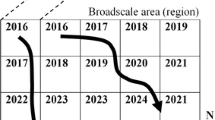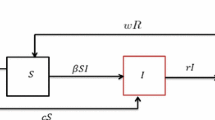Abstract
This paper presents an interdisciplinary approach to estimating the relative efficiency of static, myopic, and dynamic insecticide regulatory decision making when there are potential impacts associated with pest resistance. A theoretical control model was developed using expected total economic surplus as the objective function, with an empirical solution to the maximization problem attained by imposing a heuristic search procedure on a bioeconomic simulation model. Although the impact of non‐dynamic decision making was the most severe, in percentage terms, for short‐run planning horizons, the magnitude of the long‐run losses associated with non‐dynamic decision making could serve as a rationale for modifying the regulatory process to include dynamic considerations. The static analyses usually used in the benefits assessment procedure may severely underestimate the actual benefits of continued chemical registration, and the efficiency gains to society have the potential to offset the increased costs of regulation that would occur under a revised process.
Similar content being viewed by others
References
Almanac of the Canning, Freezing, and Preserving Industries (Edward E. Judge and Sons, various issues).
J. Alston, G.W. Norton and P. Pardey, Science Under Scarcity: Theory and Practice for Agricultural Research Evaluation and Priority Setting (Cornell University Press, 1995).
S.O. Archibald, A dynamic analysis of production externalities: pesticide resistance in California cotton, Ph.D. thesis, University of California, Davis (1984).
F. Azadivar and Y.H. Lee, Optimization of discrete variable stochastic systems by computer simulation, Math. and Computers in Simu. 30 (1988) 331-345.
H.S. Baumes and R.K. Conway, An econometric model of the U.S. apple market, U.S. Department of Agriculture, Economic Research Service Staff Report No. AGES 850110, Washington DC (1985).
E.H. Beers, L.A. Hull and G.M. Greene II, The effect of European red mite injury to apple foliage on preharvest fruit drop and efficacy of 2,4,5-TP, Hort. Sci. 19 (1984) 558-560.
E.H. Beers, L.A. Hull and J.W. Grimm, Relationships between leaf:fruit ratio and varying levels of European red mite stress on fruit size and return bloom of apple, J. Amer. Soc. Hort. Sci. 112 (1987) 608-612.
J.S. Clark and G.A. Carlson, Testing for common versus private property: the case of pesticide resistance, J. Environ. Econom. Management 19 (1990) 45-60.
D. Chapman, Computational techniques for intertemporal allocation of natural resources, Amer. J. Agr. Econom. 69 (1987) 134-142.
H.N. Comins, Analytic methods for the management of pesticide resistance, J. Theoret. Biol. 77 (1977) 171-188.
P.G. Cox and N.W. Forrester, Economics of insecticide resistance management in Heliothis armigera (Lepidoptera: Noctuidae) in Australia, J. Econom. Entomol. 85 (1992) 1539-1550.
M.J. Dover and B.A. Croft, Getting Tough: Public Policy and the Management of Pesticide Resistance, World Resources Institute Study 1 (1984).
M.J. Dover, B.A. Croft, S.M. Welch and R.L. Tummala, Biological control of Panonychus ulmi (Acarina: Tetranychidae) by Amblyseius Fallacis (Acarina: Phytoseiidae) on apple: a prey-predator model, Environ. Entomol. 8 (1979) 282-292.
G.P. Georghiou and C.E. Taylor, Factors influencing the evolution of resistance, in: Pesticide Resistance: Strategies and Tactics For Management (National Academy Press, 1986).
C.R. Harper, Optimal Regulation of agricultural pesticides: a case study of chlorodimeform in the Imperial valley, Ph.D. thesis, University of California, Berkeley (1986).
M.A. Hoy, Pesticide resistance in arthropod natural enemies: variability and selection responses, in: Pesticide Resistance in Arthropods, eds. R.T. Roush and B.E. Tabashnik (Chapman and Hall, 1990).
K.S. Huang, U.S. demand for food: a complete system of price and income effects, Technical Bulletin Number 1714, National Economics Division, Economic Research Service, United States Department of Agriculture (December 1985).
D. Hueth and U. Regev, Optimal agricultural pest management under the conditions of increasing pest resistance, Amer. J. Agr. Econom. 56 (1974) 543-552.
L.A. Hull, Insect control strategies in Pennsylvania, Mimeo, The Pennsylvania State University Fruit Research Laboratory, Biglerville (1988).
L.A. Hull and E.G. Rajotte, Effects of tufted apple budmoth (Lepidoptera: Tortricidae) injury on quality and storageability of processing apples, J. Econom. Entomol. 81 (1988) 1732-1736.
K. Klonsky, Pest management: factors influencing farmer decision making, in: Natural Resource and Environmental Policy Analysis: Cases in Applied Economics, eds. G.M. Johnston, D. Freshwater and P. Favero (Westview Press, 1988).
A.L. Knight and L.A. Hull, Area-wide population dynamics of Platynota idaeusalis (Lepidoptera: Tortricidae) in southcentral Pennsylvania pome and stone fruits, Environ. Entomol. 17 (1988) 1000-1008.
A.L. Knight and G.W. Norton, Economics of agricultural pesticide resistance in arthropods, Ann. Rev. Entomol. 34 (1989) 293-313.
W.F. Lazarus and B.F. Dixon, Agricultural pests as common property: control of the corn rootworm, Amer. J. Agr. Econom. 66 (1984) 456-465.
Y.H. Lee, Optimization of discrete variable stochastic systems by computer simulation, Ph.D. thesis, University of Illinois at Chicago (1986).
E. Lichtenberg, D.D. Parker, D. Sunding and D. Zilberman, Economics and pesticide regulation, Choices (Fourth Quarter 1997) 26-29.
G.S. Maddala, Introduction to Econometrics (Macmillan, 1988).
L.V. Madden, S.P. Pennypacker, C.E. Antle and C.H. Kingsolver, A loss model for crops, Phytopathology 71 (1981) 685-689.
M. Mangel and R.E. Plant, Multiseasonal management of an agricultural pest: I. development of the theory, Ecological Modeling 20 (1983) 1-19.
W. Mullins, Pesticide resistance management-challenges for industry,Pest Resistance Management 2 (1990) 5-7.
National Research Council, Pesticide Decision Making (National Academy of Sciences, 1978).
P. Pinstrup-Anderson, N. Ruiz de Londono and R. Hoover, The impact of increasing food supply on human nutrition, Amer. J. Agr. Econom. 58 (1976) 131-142.
V. Regev, H. Salit and A.P. Guttierrez, On the optimal allocation of pesticides with increasing resistance: the case of alfalfa weevil, J. Environ. Econom. Management 10 (1983) 86-100.
K.H. Reichelderfer and F.E. Bender, Application of a simulative approach to evaluating alternative methods for the control of agricultural pests, Amer. J. Agr. Econom. 61 (1979) 258-267.
S.L. Riley, Pyrethroid resistance in Heliothis virescens: current U.S. management program, Pesticide Sci. 27 (1989) 411-421.
J. Rowse, Does an exhaustible resource usually have many near-optimal depletion paths?, Amer. J. Agr. Econom. 70 (1988) 646-653.
Royal Society of Chemistry, The Agrochemical Handbook (Unwin Brothers, 1987).
R.M. Sawicki, Definition, detection, and documentation of insecticide resistance, in: Combating Resistance to Xenobiotics: Biological and Chemical Approaches, eds. M.G. Ford, D.W. Holloman, B.P.S. Khambay and R.M. Sawicki (Ellis Horwood, 1987).
B.E. Tabashnik, Modeling and evaluating of resistance management tactics, in: Pesticide Resistance in Arthropods, eds. R.T. Roush and B.E. Tabashnik (Chapman and Hall, 1990) pp. 153-182.
B.E. Tabashnik and B.A. Croft, Managing pesticide resistance in crop-arthropod complexes: interaction between biological and operational factors, Environ. Entomol. 11 (1982) 1137-1144.
B.E. Tabashnik and B.A. Croft, Evolution of pesticide resistance in apple pests and their natural enemies, Entomophaga 30 (1985) 37-49.
W.T. Thomson, Agricultural Chemicals, Book 1: Insecticides, Acaricides and Ovicides (Thomson Publishers, 1985).
W.G. Tomek, Apples in the United States: farm prices and uses, Cornell University Agricultural Experiment Station Bulletin No. 1022 (1968).
U.S. Department of Agriculture, Economic Research Service, Commodity Economics Division, Food, Consumption, Prices, and Expenditures, various issues.
U.S. Department of Agriculture, Economic Research Service, Commodity Economics Division, Foreign Agricultural Trade of the United States, various issues.
U.S. Department of Agriculture, National Agricultural Statistics Service, Agricultural Statistics, various issues.
U.S. Department of Agriculture, National Agricultural Statistics Service, Non-citrus Fruits and Nuts, various issues.
U.S. Department of Commerce, Bureau of the Census, Statistical Abstract of the United States, various issues.
U.S. Environmental Protection Agency, How EPA regulates pesticides, EPA J. 13 (1987) 11-14.
I.A. Watkinson, Pyrethroids and the economics of pest management, Pesticide Sci. 27 (1989) 465-469.
L.S. Willett, The U.S. apple industry: econometric model and projections, Agr. Resource Econom. Rev. 22 (1993) 137-149.
D.J. Woods, An Interactive approach for solving multi-objective optimization problems, Technical Report 85-5, Department of Mathematical Sciences, Rice University (1985).
Author information
Authors and Affiliations
Rights and permissions
About this article
Cite this article
Kazmierczak, R.F. An empirical bioeconomic investigation of efficiency in the insecticide regulatory process. Annals of Operations Research 94, 11–35 (2000). https://doi.org/10.1023/A:1018969117043
Issue Date:
DOI: https://doi.org/10.1023/A:1018969117043




